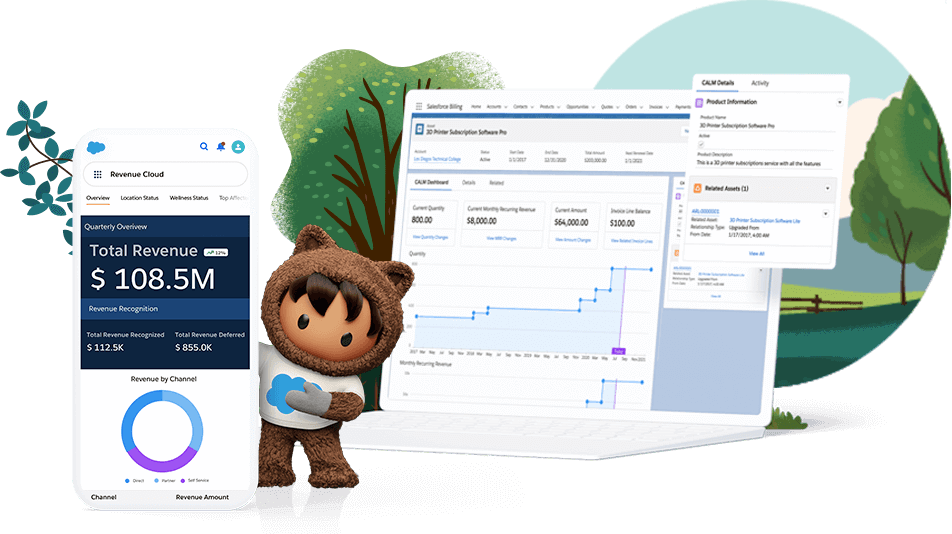At the end of 2020, Salesforce Revenue Cloud (part of the Salesforce Customer 360 Platform) was released by salesforce. It combines capabilities for Configure, Price, and Quote (CPQ), Billing, Partner Relationship Management, and B2B Commerce. The purpose is to assist organizations in better managing their revenue streams, improving forecasting skills, increasing efficiency, and speeding up growth across all sales channels.
Salesforce Revenue Cloud combines a variety of existing Salesforce products, such as Salesforce CPQ & Billing, to support and enable a more comprehensive sales engine, which includes subscriptions, recurring revenue, and consumption-based models.
WHAT IS SALESFORCE REVENUE CLOUD?

Image Source = Google | Image By – Salesforce
Salesforce Revenue Cloud has several advantages. Sales teams may learn more about the success of their income sources. They can make appropriate adjustments after reviewing the data. The program may also be used by businesses to automate manual, time-consuming activities.
Revenue Cloud enables enterprises to do the following transactions, bridging the gap between the customer and revenue lifecycles:
1. It includes a wide range of sales motions, such as:
- Direct and aided sales
- Sales through partners
- Self-service/commerce
- Sales in a certain industry (e.g., telecommunications, insurance, and energy)
2. Bundling of products and intricate order arrangement
3. Invoices can be generated from a variety of sources.
4. Make a payment
5. Management of dunning and collection
6. Reduce your financial risk as well as the amount of paperwork with which you must deal.
HOW DOES THE SALESFORCE REVENUE CLOUD WORK?
Revenue Cloud users get access to a backend that contains a summary of their sales data. Members have access to a revenue breakdown by channel. This includes anything from direct sales to partner sales to self-service.
Users will discover a revenue breakdown by product in the Revenue Cloud interface. Earnings for a certain time (e.g., quarterly) are also accessible, as well as historical statistics. The application also includes a graph illustrating recurrent revenue patterns.
Use Salesforce’s integration update to keep catalog products and pricing current. Businesses can receive payments through a variety of methods. Some of the most prevalent reasons for using Salesforce Revenue Cloud are as follows:
- Analysis of business sales trends to make future modifications
- Payment processing automation
- Management of customer service
- Salesforce Revenue Cloud can help you grow revenue if you are seeking for a means to do so.Seek assistance if:
- You are losing money because you are not charging correctly.
- You do not want to undertake an administrative job and need to free up some time.
- You have no idea where your revenue is coming from.
BENEFITS OF SALESFORCE REVENUE CLOUD: –
When used properly, the Salesforce Revenue Cloud delivers several benefits to corporations and businesses, such as the ability to create multiple invoices.
- Reduce the financial and regulatory obligations.
- The same technology will be used to prorate orders from diverse platforms, offering a uniform experience across supported, self-service, and partnership channels.
- Payments are listed.
- Transparency is offered in the lead-to-sale cycle.
- Without the requirement for sophisticated and costly compatibility with third-party billing software, receipts may be generated directly from transactions.
- Automation allows employees to focus on more essential duties and activities.
- Businesses may also use the Salesforce Revenue Cloud to keep all their revenue data in one place for themselves and their employees. Based on the number of outlets from which the customer completes the sales cycle, both parties are aware of their respective positions.
INVESTING IN SALESFORCE REVENUE CLOUD: –
The Salesforce Revenue Cloud’s benefits have already been highlighted. Some of the most compelling reasons to invest in Salesforce’s Revenue Cloud are listed below.
1. Expand Your Revenue Streams
Sales and marketing departments may use the Salesforce Revenue Cloud to implement new revenue development approaches like subscription packages and providing alternate pricing plans. These services vary from ad inventory management to newsroom content licensing. Thanks to the new Multi-Cloud-Billing functionality, businesses may now access data from many clouds on a single network.
2. It is Easier to Track Revenue
Salesforce Revenue Cloud would make it easier for salespeople to present their current products. With more sales analytics, you may find new methods to make money. You will also be aware of the amount of money coming in.
You may also use the custom Salesforce Revenue Cloud to automate time-consuming processes. Consequently, you will be able to handle your customers more effectively. Throughout the sales cycle, your partners will be held entirely accountable.
3. Increases Revenue Effectiveness
The Revenue Cloud’s best feature is its outstanding automated function, which reduces the stress of manual approvals, data verification, and order transcribing from one system to another.
Salesforce Revenue Cloud consolidates sales orders and creates invoices for them automatically. The sales cycle reduces concerns such as underbilling for services and other revenue-losing issues.
Furthermore, the user-friendly dashboard displays all things purchased by clients. Keep track of all the advancements achieved in such a transaction over time. Align and inspire diverse teams to make cost-cutting investments that are targeted.
4. Improves the Purchasing Experience
After the Revenue Cloud alters the whole purchasing decision, the purchasing experience for companies and organizations will never be the same. Using the groundbreaking Consumer Asset Lifecycle Management platform, consumers may quickly shift between direct partners, distributors, and digital shop fronts with a variety of sales channels.
Leave A Comment